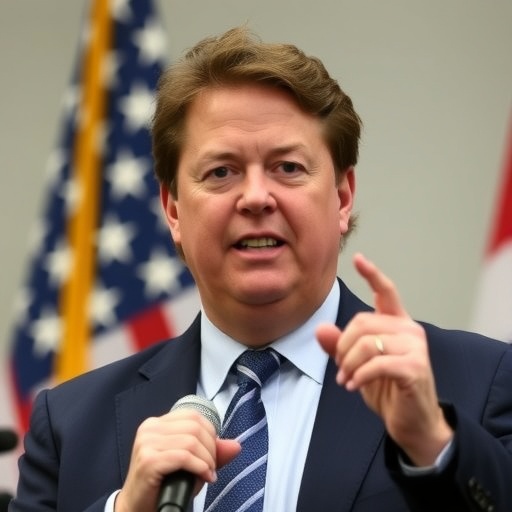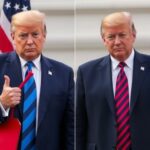Doug Ford Pulls Anti-Tariff Ad After Trump Slaps 10% Duties on Canadian Goods, Sparking Trade War Fears
In a dramatic policy U-turn that has sent shockwaves through Ontario‘s political landscape, Premier Doug Ford announced on Tuesday that his government will immediately pull a controversial anti-tariff advertisement amid escalating trade tensions with the United States. The decision comes just hours after President Donald Trump imposed a steep 10% tariff hike on a wide range of Canadian imports, targeting everything from automotive parts to agricultural products. This move not only heightens the stakes in the ongoing Canada-US trade dispute but also casts a shadow over upcoming international summits, including the ASEAN meeting in Malaysia where global trade dynamics are set to be a focal point.
The abrupt withdrawal of the ad, which had been running on television and social media platforms across Ontario and Canada, underscores the precarious balance Ford is navigating between domestic political pressures and international economic realities. Critics had already lambasted the ad for its provocative tone, accusing it of inflammatory rhetoric that could provoke further retaliation from the Trump administration. Now, with tariffs biting into Canadian exports, Ford’s reversal signals a pragmatic shift toward de-escalation, even as businesses in Ontario brace for the fallout.
Trump’s tariff announcement, delivered via a White House press briefing, cited national security concerns and unfair trade practices as justifications, echoing his long-standing grievances against Canada‘s dairy subsidies and softwood lumber policies. The 10% increase builds on existing duties, potentially adding billions to the cost of cross-border trade. For Ontario, a province heavily reliant on exports to the US—accounting for over 80% of its total shipments—this could mean job losses in key sectors like manufacturing and agriculture, with economists warning of a ripple effect across the national economy.
Ford’s Swift Reversal Exposes Cracks in Provincial Trade Strategy
Premier Doug Ford’s decision to yank the anti-tariff ad was as swift as it was surprising, coming less than 24 hours after Trump’s tariff bombshell. In a statement released from Queen’s Park, Ford explained that the ad, titled “Don’t Let Tariffs Tear Us Apart,” had been intended to rally public support against potential US protectionism. However, with the tariffs now a harsh reality, Ford admitted the messaging had become “counterproductive.” “We need to focus on solutions, not slogans,” Ford said in an interview with CBC News. “Ontario workers can’t afford more division; they need stability.”
The ad itself, which debuted two weeks ago, featured dramatic imagery of factory workers in Windsor and farmers in rural Ontario facing empty assembly lines and barren fields, narrated by a gravelly voice decrying “American bullying.” It quickly amassed over a million views on YouTube but drew sharp criticism from business leaders and even some within Ford’s own Progressive Conservative party. The Canadian Chamber of Commerce called it “reckless provocation,” arguing that it risked alienating US partners at a time when negotiations were crucial.
Behind the scenes, sources close to the premier reveal that internal polling showed the ad polarizing voters, with urban Ontario residents supportive but rural exporters worried about backlash. Ford’s team had initially defended the campaign as a necessary wake-up call, but Trump’s immediate response—labeling Canada a “trade cheater” on Twitter—forced a rethink. The ad’s budget, estimated at $500,000 from provincial funds, now represents a sunk cost in a high-stakes game of economic chicken.
This reversal isn’t Ford’s first brush with US trade policy. During his 2018 election campaign, he positioned himself as a tough negotiator against NAFTA renegotiations, but his administration has since adopted a more conciliatory tone. Political analysts suggest the ad pull is a calculated move to reposition Ontario as a reliable partner, potentially paving the way for bilateral talks. Yet, questions linger about the ad’s origins: Was it a genuine policy statement or a bid for populist appeal ahead of the next provincial election?
Trump’s Tariff Hike Targets Key Canadian Exports, Igniting Economic Alarm
President Trump’s 10% tariff escalation on Canadian goods marks a significant intensification of the trade war that has simmered since his first term. Announced during a rally in Ohio, the measures specifically target Ontario‘s auto sector, which sends over $20 billion in vehicles and parts south of the border annually. Steel and aluminum duties, already in place at 25%, now compound with these new levies, creating a perfect storm for manufacturers in cities like Oshawa and Hamilton.
According to a report from the Bank of Canada, the tariffs could shave 0.5% off Canada‘s GDP growth in the coming year, with Ontario bearing the brunt due to its export dependency. The auto industry alone employs 125,000 people in the province, and industry groups like the Canadian Vehicle Manufacturers’ Association warn of up to 50,000 job losses if retaliatory measures fail. “This isn’t just numbers on a page; it’s families in Ontario wondering if they’ll have work tomorrow,” said association president David Adams in a press release.
Trump justified the hike by pointing to Canada‘s supply management system for dairy, which he claims disadvantages US farmers. “Canada has been ripping us off for years,” Trump declared, referencing a 2018 US Trade Representative report that alleged $16 billion in annual losses from Canadian practices. In response, Canada‘s federal government, led by Prime Minister Justin Trudeau, has vowed countermeasures, including potential tariffs on US whiskey and motorcycles—echoing 2018’s tit-for-tat exchanges.
But the devil is in the details. The new duties apply to over 2,500 product categories, from maple syrup to machinery, affecting small businesses as much as giants like Magna International. In Ontario‘s Niagara region, wine exporters fear a 10% price bump could crush sales in the US market, which accounts for 40% of their revenue. Economists at the University of Toronto estimate the total hit to Canada at $4.5 billion annually, prompting calls for federal subsidies to buffer the blow.
- Key Sectors Impacted: Automotive (primary target), agriculture (dairy and grains), and manufacturing (steel-dependent goods).
- Historical Context: Builds on 2018 tariffs that cost Canada $1.4 billion in exports before partial resolution via USMCA.
- Expert Prediction: RBC Economics forecasts a 2-3% rise in consumer prices for tariff-affected goods in Ontario.
As the tariffs take effect next month, supply chain disruptions are already evident, with some US buyers scrambling to source alternatives from Mexico or Europe. This shift not only strains Canada-US relations but also highlights the fragility of North American integration in an era of resurgent protectionism.
Controversial Ad’s Fallout Reveals Deep Divisions in Canadian Politics
The anti-tariff ad that Ford is now scrapping had been a lightning rod for debate since its launch, exposing fault lines within Canada‘s political and business communities. Produced by the Ontario Ministry of Economic Development, the 30-second spot portrayed Trump as a shadowy figure imposing barriers on hardworking Canadians, complete with visuals of locked borders and idled factories. While it resonated with anti-Trump sentiments in urban centers like Toronto, it alienated conservative voters in border regions who rely on seamless trade.
Opposition leaders pounced on the ad’s tone. NDP Leader Andrea Horwath called it “divisive fearmongering,” arguing that it undermined federal efforts to negotiate with Washington. “Doug Ford is playing politics with people’s livelihoods,” Horwath stated during Question Period. Even federal Conservative Leader Pierre Poilievre, a vocal Trump supporter, distanced himself, tweeting that Canada should “lead with strength, not ads.” The ad’s controversy peaked when US Ambassador to Canada David MacNaughton lodged a informal complaint, warning of strained diplomatic ties.
Public reaction was mixed, per a Leger poll conducted last week: 55% of Ontario residents approved of the ad’s message, but 62% believed it could provoke retaliation—prophetic in light of Trump’s actions. Social media amplified the divide, with hashtags like #StandAgainstTariffs trending alongside #FordFail. For Ford, who rose to power on a pro-business platform, the ad represented a gamble that backfired spectacularly, eroding his image as a steady hand on the economy.
Looking deeper, the ad’s withdrawal hints at broader frustrations with federal trade policy. Ontario, as Canada‘s economic powerhouse contributing 38% of national GDP, has long chafed at Ottawa’s handling of US relations. Ford’s move could signal a push for more provincial autonomy in trade matters, potentially leading to direct negotiations with US states like Michigan and New York, which share economic interdependence.
ASEAN Summit Looms as Trade Tensions Threaten Global Ripple Effects
With the ASEAN summit in Malaysia just weeks away, the Ford-Trump tariff spat arrives at a precarious moment for international trade. The gathering, attended by leaders from 10 Southeast Asian nations plus dialogue partners like Canada and the US, was meant to foster multilateral agreements on supply chains and digital trade. However, Trump’s duties could derail discussions, as Canada seeks allies to counter US unilateralism.
Prime Minister Trudeau is expected to use the platform to rally support, emphasizing the USMCA’s spirit of cooperation. “Tariffs hurt everyone, from Ontario factory floors to Malaysian ports,” Trudeau said in a pre-summit address. Analysts predict the summit could see side deals between Canada and ASEAN countries to diversify exports away from the US, with Ontario agribusiness eyeing opportunities in palm oil alternatives and tech components.
Yet, the risks are high. If Trump attends—as rumored—the summit might become a flashpoint, with his “America First” agenda clashing against calls for fair trade. For Doug Ford, sidelined from the international stage, the focus shifts to domestic mitigation: emergency funds for affected industries and lobbying for federal relief. Business groups like the Ontario Economic Council urge a “cooling-off period,” advocating quiet diplomacy over public spats.
Looking ahead, the tariff hike could catalyze long-term changes in Canada‘s trade posture. Investments in domestic manufacturing, green energy exports, and deeper ties with Europe via CETA are on the table. Ford has hinted at a “trade resilience task force” for Ontario, aiming to shield jobs from future shocks. As tensions simmer, the hope is that dialogue prevails, preventing a full-blown trade war that could reshape North American economies for years to come. With billions at stake and livelihoods hanging in the balance, all eyes are on whether Ford’s pivot and upcoming summits can steer toward resolution.
(This article draws on official statements, economic reports, and expert analyses as of the publication date. Developments may evolve rapidly.)









